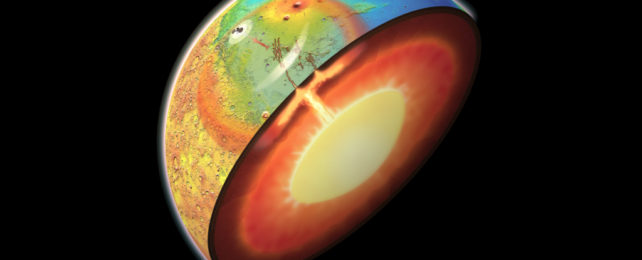Scientists may have just identified the culprit behind signs of recently active volcanism on Mars.
Beneath a broad plain called the Elysium Planitia, a colossal, 4,000-kilometer (roughly 2,500-mile) wide convection plume in the Martian mantle could be driving molten magma up as far as the surface. This could explain multiple lines of evidence that tantalizingly point to a volcanic Mars.
"Our results demonstrate that the interior of Mars is geodynamically active today," write planetary geophysicists Adrien Broquet and Jeffrey Andrews-Hanna of the University of Arizona, "and imply that volcanism has been driven by mantle plumes from the formation of the Hesperian volcanic provinces and Tharsis is the past to Elysium Planitia today."
Mars has shown very convincing signs of being geologically dead, inside and out. Its relatively old surface – seeming to lack recent volcanic resurfacing and tectonic motion – and absence of a global magnetic field have been held up as reasons to think there's little else but firm, motionless rock all the way down to the core.
Recent observations have poked significant holes in the notion of a completely dead Mars. There was a meteorite from Mars that made its way to Earth that showed signs of mantle convection as recently as around half a billion years ago for example.
Then satellite photos revealed evidence of volcanic surface deposits as young as 50,000 years old in a fissure system called the Cerberus Fossae.
And then Mars InSight, a lander monitoring the Mars interior since November 2018, revealed significant ongoing seismic activity consistent with volcanism.
There have been a few other odd observations. The local gravity field of the Elysium Planitia, for example, is unusually strong, consistent with some sort of subsurface activity.
So Broquet and Andres Hanna collected topographical, gravity, geological, and seismic data, and set about finding a model that fits it.

According to their analysis, a mantle plume ticks all the boxes. These are upwellings of hot interior material that push against the core-mantle boundary of a planet, forcing magma upwards and forming crustal hotspots and surface volcanism.
To match the observed data – including the epicenters of seismic activity as detected by InSight – the plume would be at least 3,500 kilometers across, and sitting between 95 and 285 Kelvin warmer than its surroundings. That's 95 to 285 degrees Celsius, or 171 to 513 degrees Fahrenheit.
This is very similar to mantle plumes on Earth that drove the prehistoric volcanic activity responsible for extensive surface sculpting – the Deccan Traps and the North Atlantic Igneous Province.
"Although Mars is smaller than the Earth, the formation of similarly large plume heads is expected given the lower gravity and higher viscosity of the Martian mantle," the researchers write in their paper.
"The best-fit plume head center, based solely on gravity and topography data, is precisely located at the center of the Cerberus Fossae, where both recent volcanism and most marsquakes have been located."
This, the researchers say, means that Mars would be the third Solar System planet with mantle plume activity, joining Earth and Venus.
It's a result that means some pretty interesting things for Mars. Maybe not surface volcanoes spewing lava everywhere, but interior heating that could keep lakes under the Martian surface from freezing solid. This has implications for the search for Martian life – microbes that might be hidden in such lakes, living their quiet lives away from human detection.
"Ongoing plume activity demonstrates that Mars is not only seismically and volcanically active today, but possesses a geodynamically active interior as well," Broquet and Andrews-Hanna write.
"A plume beneath Elysium Planitia also indicates that the surface volcanic flows and seismic activity are not isolated events, but part of a long-lived, actively sustained, regional system, with implications for the longevity and astrobiological potential of subsurface habitable environments."
The research has been published in Nature Astronomy.
